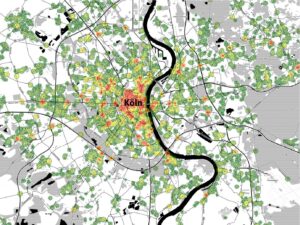The Master Thesis of Jan Kinne on the subject: “The Geographic Dispersal of the German Software Industry – Geospatial Analysis and Location Pattern Modeling” won the price “Nachwuchsförderpreis Geoinformatik 2017” of the “Runde Tisch GIS e.V.” in the category ‘Master Thesis’ with a value of 1.500 Euro.
In addition Jan did also win the audience price for the best presentation of the thesis.
The price was handed to Jan Kinne in a ceremony at the GI-Runde 2017 (Mon 20.Feb 2017) in Munich. We congratulate Jan cordially for this achievement!
Jan Kinne studied Geography with a focus on GIScience at Heidelberg University and wrote the thesis in cooperation with ZEW Mannheim (Centre for European Economic Research) using data of the “Mannheim Enterprise Panel“.
The research within the scope of this thesis aims to contribute to Location Theory. The applied interdisciplinary approach incorporates Regional Science, Economic Geography and Geographic Information Science. The research objective is to analyse the geographic dispersal of German software firm locations. These firm locations are derived from geocoded postal addresses of a multi-year firm census. The resulting point data set allows for the analysis of non-aggregated firm locations in Germany for the first time. It is shown that such detailed geographic data can be used to detect information on location determinants,
which are superimposed when aggregated spatial units are analysed. In an exploratory geospatial data analysis, it is found that the regional settlement structure and the interaction of rural and urban areas have an impact on the local dispersal of software firm locations. In a subsequent regression analysis, the thus identified location determinants are used to model a function that predicts the local occurrence of software firms within each square kilometre of Germany. It is shown that the relationship between the number of software firms and the predicting location factors can be adequately estimated. However, it becomes apparent that a spatial regression model may yield better results than a single global model.
 Foto: (c) Runder Tisch GIS
Foto: (c) Runder Tisch GIS
The thesis was written in English, yet here you can find an abstract in German.



